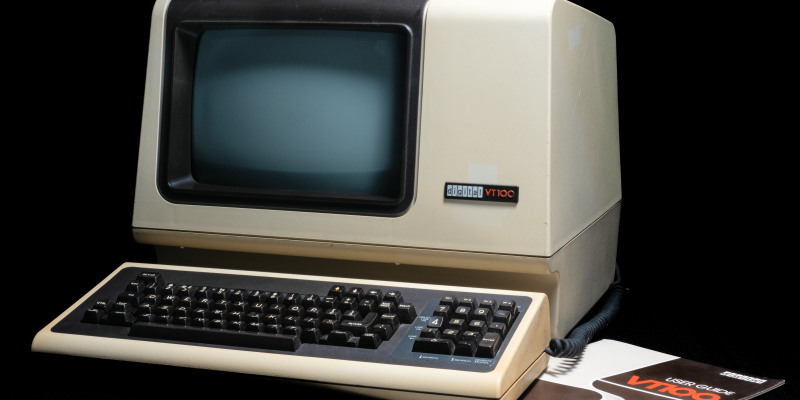
DEC VT100
As you may have seen from the Teletype display, early computing did not use graphics displays. After mechanical typewriters we saw the wide spread use of “electronic Teletypes”. These displayed the same as a typewriter but on a screen, some basic graphics were possible. A very popular version was the VT100.
This is a VT100. It is what is called a dumb terminal. It’s dumb as it takes the data feed and just writes the data on the screen. There are codes sent to clear the screen, change the size of the fonts etc. but that's it. It was introduced in 1978.
The VT100's were connected to the main computer using simple serial lines running at data rates of 9,600 characters per second (Baud). These line often failed, especially during thunderstorms.
One of the main computers used then was the PDP 11/45. This machine had to operate in a controlled environment, with carefully controlled temperature and humidity.
A complete main computer might have 32K of main memory, to support 64 users. The memory was relatively slow, and very expensive. Typically operating at 200ns and costing tens of thousands of pounds.
Ultimately, over six million terminals in the VT series were sold, based largely on the success of the VT100.
These terminals live on in Linux and OSX as the 'terminal' app simulate exactly these terminals, such that if you send the data from the terminal ‘app’ to the VT100 you will get the same data on the VT100 screen as you will on the terminal 'app'.
Related links
The VT100 is a video terminal, introduced in August 1978 by Digital Equipment Corporation (DEC). It was a robust and well-built machine. It was one of the first terminals to support ANSI escape codes for cursor control and other tasks, and added a number of extended codes for special features like controlling the status lights on the keyboard. This led to rapid uptake of the ANSI standard, which became the de facto standard for hardware video terminals and later terminal emulators.
The VT100 series, especially the VT102, was extremely successful in the market, and made DEC the leading terminal vendor at the time. The VT100 series was replaced by the VT200 series starting in 1983, which proved equally successful. Ultimately, over six million terminals in the VT series were sold, based largely on the success of the VT100.
Main storage for these machines typically existed on large disk drives which might store 10-50Mb per disk. An example is shown below.
To hold large datasets and backups, the department used tape drives. Large spools of magnetic tape. This example shows a tape that could hold XX Mb of data. Access times were slow although storage was relatively reliable. The tapes had to be loaded by hand.
The VT100 also introduced an additional box-drawing character set containing various pseudographics that allowed the drawing of on-screen forms. All configuration setup of the VT100 was accomplished using interactive displays presented on the screen; the setup data was stored in non-volatile memory within the terminal. Maintainability was also significantly improved, since a VT100 could be quickly dismantled into replaceable modules.
In 1983, the VT100 was replaced by the more powerful VT200 series terminals such as the VT220.